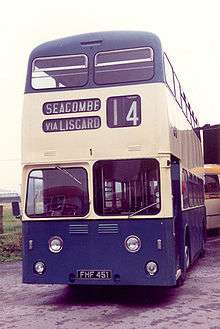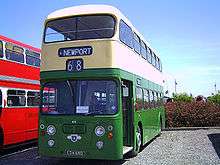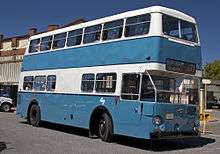Leyland Atlantean
| Leyland Atlantean | |
|---|---|
%2C_2012_MMT_Christmas_Cracker.jpg) 4706 - A706LNC - Preserved Northern Counties-bodied Atlantean seen here in Manchester on 1 December 2012 | |
| Overview | |
| Manufacturer | Leyland |
| Production | 1958 - 1986 |
| Body and chassis | |
| Doors | 1-2 |
| Floor type | Step entrance |
| Powertrain | |
| Engine |
Leyland 0.600 Leyland 0.680 Leyland 0.690 |
| Dimensions | |
| Length | 9.14–10.2 metres (30.0–33.5 ft) |
| Chronology | |
| Successor | Leyland Olympian |
The Leyland Atlantean is a double-decker bus chassis manufactured by Leyland Motors between 1958 and 1986.
It pioneered the design of rear-engined, front entrance double deck buses in the United Kingdom, allowing for the introduction of one man operation buses, dispensing with the need for a bus conductor.
The prototypes
In the years immediately following World War II, bus operators in the United Kingdom faced a downturn in the numbers of passengers carried and manufacturers began looking at ways to economise. A few experimental rear-engined buses had been produced before the war but none successfully made it beyond the prototype stage. The need to minimise the intrusion of the engine into passenger carrying space was a priority, leading to several underfloor-engined single-deck designs. However, such designs raised the height of the floor of the vehicle, forcing additional steps at the entrance. On double decker buses, these problems were amplified, causing either an increase in the overall height of the vehicle or an inadequate interior height.
In 1952, Leyland began experimenting with ideas for a rear-engined double-decker bus. A prototype was built, with a body by Saunders-Roe, to the maximum permitted width of 7 feet 6 inches (2.29 m). It was fitted with a turbocharged version of the Leyland 0.350 engine, which was transversely mounted at the rear of the sub-frame. The chassis was a platform-type frame of steel and light alloy with deep stressed side-members. An automatic clutch and self change gearbox were also fitted. The vehicle was designated the PDR1 (R for "Rear-engined").
In 1956, a second prototype was constructed, this time with a Metro-Cammell body and, again equipped with a 0.350 engine fitted across the frame. It had a centrifugal clutch, Pneumocyclic gearbox and angle drive. This vehicle was 13 feet 2.75 inches (4.0323 m) in height, with a 16-foot-2.875-inch (4.94983 m) wheelbase and overall length of 29 feet 10 inches (9.09 m) and had a seating capacity of 78. Leyland christened this prototype the Lowloader.
Though two prototypes were thoroughly tested, the same problem of a front-engined bus remained, they had rear entrances with the space alongside the driver being wasted.
PDR1/PDR2

An amendment to the Construction and Use Regulations in 1956 saw the maximum length for double-deckers increased to 30 feet (9.1 m), allowing a wider entrance to be located ahead of the front axle. This was initially to allow the driver to supervise boarding whilst the conductor collected fares, but quickly it became apparent that the design would allow for one man operation. Leyland took advantage of the new regulation to launch the first prototype Atlantean at the 1956 Commercial Motor Show at Earls Court Exhibition Centre.[1][2] Though it featured the front entrance design that would redefine the bus industry, several factors prevented the bus going on the market. The main problem was the high level of engine noise inside the lower saloon, as the engine was still inside the body, with the compartment being used for bench seating.
Mechanically, the prototype Atlantean was similar to the Lowloader with an 0.600 engine transversely mounted at the rear with a pneumo-cyclic gearbox situated in the rear offside corner providing drive in a straight line from the engine. The Atlantean had a light and strong fabricated frame. Light alloy floor plates were rivetted directly to the framework, fulfilling the dual purpose of reinforcing the frame and providing a foundation for the saloon floor. The platform-type sub-frame concept from the Lowloader was retained for the prototype. A drop-centre rear axle allowed the flat floor, only one step up from ground level, to continue for the full length of the bus.
The prototype was demonstrated around the country to various operators. It also had an unregistered sister vehicle, which was used as a testbed. Both were subsequently scrapped.

By 1958, Leyland had overcome most of the problems and moved the engine to a rear-mounted compartment outside the main body and the first production Atlantean PDR1/1, with a 16-foot-3-inch (4.95 m) wheelbase, was launched at the 1958 Commercial Motor Show. It had simpler mechanical specification than the prototype, with conventional front and rear axles, leaf springs all round and a channel section frame. Glasgow Corporation, James of Ammanford and Wallasey Corporation each put their first example of the type into service in December 1958.[3]
From 1964, a drop-centre rear axle was available as an option for the Atlantean; the Atlanteans with drop-centre rear axles became known as the Atlantean PDR1/2 and, for the later version, the Atlantean PDR1/3. In 1967, Leyland launched the Atlantean PDR2/1 which could be fitted with 33-foot-long bodywork (10 m).[4][5]
In 1965, London Transport purchased a fleet of 50, initially operating on routes 7, 24, 67 and 271 before being transferred to Croydon.[6][7][8][9]
.jpg)
Though some operators initially continued to buy front-engined vehicles for reliability, the Atlantean became very popular. Though the National Bus Company and the Scottish Bus Group favoured the Bristol VR and Daimler Fleetline respectively, the Atlantean proved popular with municipal operators. Aberdeen, Bournemouth, Glasgow, Edinburgh, Newcastle, Manchester, Liverpool, Newport, Nottingham and Plymouth Corporations purchased large numbers of the type.
In 1968, three Atlanteans were bodied by Marshall as single deck buses for Great Yarmouth Corporation.[10] By 1972, over 6,000 Atlanteans had entered service.[11][12]
AN68/AN69


In February 1972, Leyland announced the AN68 series to replace the PDR1/PDR2.[13] The new chassis provided a wider entrance and several new safety features were included. An audible and visible alarm discouraged engine overheating by giving the driver due warning. A fail-safe parking brake was introduced, while the steering box and brake controls were protected against damage from severe head-on collision and stainless steel air-piping gave greater resistance to corrosion.[14]
Two models were offered: AN68/1R (9.4m in length) and AN68/2R (10.2m in length). Power assisted steering was standard on the AN68/2R and optional on the AN68/1R. The steering pump was power driven, which replaced the early belt driven system, while the only available engine was the new Leyland 0.680. A wide variety of body styles from various manufacturers continued to be offered, allowing the Atlantean to be tailor made to requirements from operators ranging from the small independent to the large city corporation.
In 1978, Leyland started to offer the AN69 with Leyland 0.690 (a turbocharged variant of the 0.680 engine, all were sold to overseas operators.[15]
The Atlantean continued to sell in large numbers, with many operators proving loyal to it.[16] London Transport however, notably it chose the Daimler Fleetline over the AN68 for its first large rear-engined double-deck order. Though over 2,000 Fleetlines would be purchased, reliability problems let to their very premature withdrawal.
The formation of British Leyland in 1968 saw rivals Daimler and Bristol merge with Leyland, bringing the two competing rear-engined chassis (Daimler Fleetline and Bristol VR) together with the Atlantean. Though the Bristol brand was retained, Daimler was dropped and products were re-badged as Leylands. After the re-organisation, Leyland set out to develop a new rear-engined double-deck bus for the London market to replace the troublesome Fleetlines. This new vehicle, the Titan B15 spawned a simpler, non-integral offshoot, the Olympian, which debuted in 1980. Though the Olympian was meant as a direct replacement for the VR, Fleetline and Atlantean, the venerable AN68 continued in production alongside the Olympian until 1986. The last Atlantean for the domestic market rolled off the production line in 1984, the last of a batch for Merseyside PTE, while the export version remained in production for a further two years, with deliveries to the city operator in Baghdad, Iraq.
By the end of production, over 15,000 Atlanteans had been built. Greater Manchester PTE (and its predecessors) was the largest operator of the Atlantean with 'Greater Manchester Standard' bodies from Northern Counties and, to a lesser extent, Park Royal. Second was Glasgow Corporation/Greater Glasgow PTE most of which were bodied by Walter Alexander. Third was Merseyside PTE who took approximately 800 Atlanteans mostly bodied by Walter Alexander and East Lancs although there were smaller batches with MCW and Willowbrook bodies.
Exports

Singapore
Singapore Bus Service received 520 Leyland Atlantean AN68/2Rs between 1977 and 1986 in three batches with the bodywork provided by Metal Sections/Duple Metsec, British Aluminium Company and Walter Alexander.[17][18][19][20] The Singapore Leyland Atlanteans were withdrawn between 14 January 1990 and 19 December 2000.[21][22][23] They were split as follows:
- The 101 Alexander L bodied buses were sold to Citybus (Hong Kong) when Leyland Olympian 3-Axles are delivered between August 1993 and April 1994. All the Citybus Leyland Atlanteans were withdrawn in 1998 when it became fully air-con and the lifespans were up to 17 years.
- All the Leyland Atlantean (BAco) buses were scrapped in 1990.
- Some of the Duple Metsec buses were sold to China between May 1993 and August 1995.
- The Alexander R buses were slowly phased out after 1996, and had 100 buses left in 1998 when it converted to fully air-con buses. The rest of them were retired by 19 December 2000, with the last buses on 222 and 291 being replaced by enough Volvo Olympian 2-Axles transferred from Bedok North Depot, when service 10 and 196 became fully air-con by then.
United States
A small fleet of Atlanteans also crossed the Atlantic, entering service in New York City. The double-deckers arrived in 1976, but proved problematic. After finally getting the too-tall buses from the docks, it was discovered that their height made them unsuitable for use on Fifth Avenue, and due to an underdimensioned air-conditioning system they could not be operated in the height of summer. New York's heavily potholed roads also took a toll, and after the Atlanteans spent most of their time being repaired the fleet was quietly withdrawn in 1980.[24][25][26]
Australia
In Australia, a fleet of 224 were bodied by Pressed Metal Corporation for the Public Transport Commission, Sydney between 1970 and 1973. Reliability and industrial relations issues plagued the fleet with withdrawals commencing in 1979.[27] A deal was concluded to sell the fleet to China Motor Bus, however the incoming Government of New South Wales blocked the deal.[28] The final examples were withdrawn in 1986, by which time they were concentrated on route 190 to Palm Beach. [29] These were the first double deck buses bodied in Australia for 17 years, and would be the last until the Bustech CDi in 2011. Many would go on to have longer careers after being sold, and some still are in service today, often in open top configuration.[30]
Many former municipal bus company Atlanteans were imported into Australia in the 1970s. Australian Pacific Tours, Kirkland Bros Omnibus Services of Lismore, Sita Buslines and Westbus of Sydney among the operators.[31] In April 1974 a PDR1A/1 chassis originally intended for Southampton Corporation but fire damaged at East Lancashire Coachbuilders was bodied by Pressed Metal Corporation as a single deck bus for Seven Hills Bus Co.[31][32]
Other countries
Atlanteans were also exported to Baghdad Passenger Transport Services (600),[33][34] Córas Iompair Éireann (840),[35][36] Jakarta (108),[37] Kuwait,[38] Manila (22),[39] Portugal (130)[40] and Storstockholms Lokaltrafik (50).[41]
Competitors
Though the Atlantean was the first high-volume rear-engined double-decker on the market, Daimler was quick to catch up with its Fleetline model. Bristol followed several years later with its VRT.
The Bristol was favoured by the state-owned National Bus Company, several of whose predecessors had standardised on Bristol vehicles. Several early examples were also purchased by NBC's Scottish sister company, the Scottish Bus Group, where the front-engined Bristol Lodekka had proved popular. However, the Scottish customers did not share the same enthusiasm for the VR and the vehicles purchased were swapped for ex-NBC Lodekkas. The Scottish Bus Group then standardised on the Daimler Fleetline for its double-deck needs.
After the re-organisation of British Leyland, both VR and Fleetline became Leyland offerings and, when production of both ceased in 1981, over 6,400 VRs and 11,500 Fleetlines had been built. Frustrated at the lack of competition to Leyland, some operators turned to other manufacturers, who began to offer alternatives to the state-owned manufacturer. Supply problems at Leyland did not help matters and products such as the Scania Metropolitan and Dennis Dominator began to make small inroads into the rear-engined market, while the Volvo Ailsa B55 reintroduced a front-engined double-deck chassis, with a front entrance, with some success. The Scania/Metro Cammell Weymann partnership, which produced the Metropolitan, ended in the late 1970s and forced MCW to introduce its own rear-engined product, available as an integral or chassis, the MCW Metrobus. The success of the Metrobus, particularly with West Midlands Passenger Transport Executive and London Transport, would spur Leyland on to develop a new heavy-duty rear-engined bus, sealing the eventual withdrawal of the Atlantean from the market.
References
- ↑ Rear Engine in New Double-decker Commercial Motor 7 September 1956
- ↑ Latest at Earls Court Commercial Motor 21 September 1956
- ↑ The Atlantean Gets Down to Business Commercial Motor 5 September 1958
- ↑ Larger Leyland Atlantean Commercial Motor 9 September 1966
- ↑ Manchester Orders 33-footers from Daimler and Leyland Commercial Motor 13 January 1967
- ↑ Routes for LTB Atlanteans Commercial Motor 18 June 1965
- ↑ LTB Atlanteans entering service Commercial Motor 5 November 1965
- ↑ LT's first o-m-o double decker Commercial Motor 14 November 1969
- ↑ LT to sell its Atlanteans Commercial Motor 12 January 1973
- ↑ First single-deck Atlanteans Commercial Motor 15 March 1968
- ↑ Leyland Atlantan PDR1 Bus Fleet Lists on the Web
- ↑ Leyland Atlantean PDR2 Bus Fleet Lists on the Web
- ↑ New model Atlantean Commercial Motor 4 February 1972
- ↑ New from Leyland - the AN68 Atlantean Commercial Motor 4 February 1972
- ↑ Leyland Atlantean AN69 Bus Fleet Lists on the Web
- ↑ Leyland Atlantean AN68 Bus Fleet Lists on the Web
- ↑ £1.1m sale Commercial Motor 8 September 1978
- ↑ New buses for old in Singapore Commercial Motor 1 December 1979
- ↑ Exporting to survive Commercial Motor 5 July 1980
- ↑ Biggest Alexander order Commercial Motor 20 August 1983
- ↑ Atlantean AN68/2R Leyland Page
- ↑ Leyland Atlantean AN68A/2RA Bus Datafile
- ↑ "Hong Kong Buses Part 2: Citybus Limited" Fleetline issue 248 May 1997 page 94
- ↑ Atlantean plans run aground Commercial Motor 7 May 1976
- ↑ Deckers pulled up Commercial Motor 26 January 1980
- ↑ Taylor, Bill (June 1980). "Intertruck: USA". Truck. London: FF Publishing: 46, 49.
- ↑ Deckers going Commercial Motor 12 January 1979
- ↑ "Hong Kong Buses Part 1: China Motor Bus Co" Fleetline issue 247 March 1997 page 49
- ↑ Double decker buses set for Sydney Transport for NSW 24 August 2012
- ↑ State Transit Authority Disposal Lists Australian Bus Fleet Lists
- 1 2 Tilley, Bruce (1986). British Buses in Australia. Elizabeth, South Australia: Railmac Publications. pp. 8–19,51. ISBN 0 949817 52 X.
- ↑ MO9750 Bus Australia gallery
- ↑ Biggest order yet for BL Commercial Motor 2 August 1974
- ↑ A slice of the cake Commercial Motor 16 February 1980
- ↑ Atlanteans Invade Irish Republic Commercial Motor 24 June 1966
- ↑ Striking New CIE Atlanteans Commercial Motor 11 November 1966
- ↑ KMB sees double Commercial Motor 1 November 1980
- ↑ News Brief Commercial Motor 19 July 1986
- ↑ Leyland goes East Commercial Motor 14 June 1980
- ↑ Leyland Wins Big Portuguese Orders Commercial Motor 27 August 1965
- ↑ Leyland Gets Stockholm's Order Commercial Motor 11 June 1965
External links
 Media related to Leyland Atlantean at Wikimedia Commons
Media related to Leyland Atlantean at Wikimedia Commons- Bus Australia gallery
- Flickr gallery